The History Book Club discussion

This topic is about
Rubicon
ROMAN EMPIRE -THE HISTORY...
>
SERIES - GLOSSARY - POTENTIAL SPOILERS
This is a Wikipedia article about Brutus' mother who we are introduced to right away in this book: (Servilla Caepionis)
http://en.wikipedia.org/wiki/Servilia...
http://en.wikipedia.org/wiki/Servilia...
This is a photo of the actress playing Servilla in the TV series Rome:
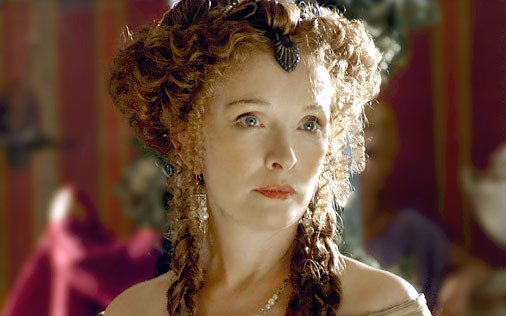
Screenshot of Lindsay Duncan as Servilia of the Junii from HBO's Rome.

Screenshot of Lindsay Duncan as Servilia of the Junii from HBO's Rome.
message 4:
by
Bentley, Group Founder, Leader, Chief
(last edited Apr 17, 2012 09:03AM)
(new)
-
rated it 3 stars

Male portrait, so-called “Brutus”. Marble, Roman artwork, 30–15 BC. From the Tiber, Rome.
Marcus Junius Brutus the Younger
http://en.wikipedia.org/wiki/Marcus_J...
message 6:
by
Bentley, Group Founder, Leader, Chief
(last edited Apr 17, 2012 10:53AM)
(new)
-
rated it 3 stars
These are the fasces which were carried by lictors:

Regarding Fasces:
http://en.wikipedia.org/wiki/Fascio_l...
Source; Wikipedia

Regarding Fasces:
http://en.wikipedia.org/wiki/Fascio_l...
Source; Wikipedia
I hope everyone has a chance to dip into the Glossary at the back of the book. It's very interesting, kind of like a mini-course in Roman history. For instance, the entry about the Gold of Tolosa provides a really good summary of how Servilia's brother Caepio got so rich. The incident was dealt with in detail in the first book of the series, The First Man in Rome.
http://en.wikipedia.org/wiki/The_Gold...
http://en.wikipedia.org/wiki/Quintus_...
 by
by
 Colleen McCullough
Colleen McCullough
http://en.wikipedia.org/wiki/The_Gold...
http://en.wikipedia.org/wiki/Quintus_...
 by
by
 Colleen McCullough
Colleen McCullough
Aurelia - Caesar's Mother
http://karl-leon-ciccone.suite101.com...
http://en.wikipedia.org/wiki/Aurelia_...

http://karl-leon-ciccone.suite101.com...
http://en.wikipedia.org/wiki/Aurelia_...

message 13:
by
Bentley, Group Founder, Leader, Chief
(last edited Apr 18, 2012 10:06AM)
(new)
-
rated it 3 stars
Explanation of the Layout of the Roman Home and Atriums mentioned in Chapter 1.
http://www.roman-empire.net/society/s...
Source: Illustrated History of the Roman Empire

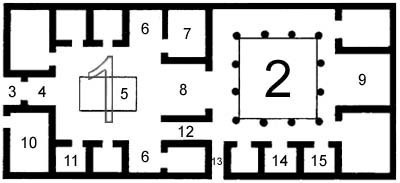
http://www.roman-empire.net/society/s...
Source: Illustrated History of the Roman Empire


One of the Seven Hills of Rome - Palatine:

Source: Clivus Palatinus
Xerones - From Flickr Creative Commons License
The area of the Palatine is about 25 acres. It is the central hill of the seven hills of Rome. It was the first hill area to become a settlement. Much of the Palatine has not been excavated, except for the area nearest the Tiber. The residence of Augustus (and Tiberius, and Domitian), the Temple of Apollo and temples of Victory and the Great Mother are there. The exact location on the Palatine of Romulus' home and the Lupercal cave are unknown.
Update: BBC News' 'Mythical Roman cave' unearthed reported, on November 20, 2007, that Italian archaeologists think they've found the Lupercal cave, near the palace of Augustus, 16m (52ft) underground. The dimensions of the circular structure are: 8m (26ft) high and 7.5m (24ft) in diameter.

Source: Clivus Palatinus
Xerones - From Flickr Creative Commons License
The area of the Palatine is about 25 acres. It is the central hill of the seven hills of Rome. It was the first hill area to become a settlement. Much of the Palatine has not been excavated, except for the area nearest the Tiber. The residence of Augustus (and Tiberius, and Domitian), the Temple of Apollo and temples of Victory and the Great Mother are there. The exact location on the Palatine of Romulus' home and the Lupercal cave are unknown.
Update: BBC News' 'Mythical Roman cave' unearthed reported, on November 20, 2007, that Italian archaeologists think they've found the Lupercal cave, near the palace of Augustus, 16m (52ft) underground. The dimensions of the circular structure are: 8m (26ft) high and 7.5m (24ft) in diameter.
One of the Seven Hills of Rome - Esquiline Hill
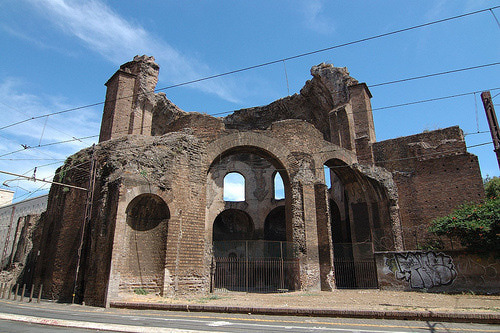
Source: Temple of Minerva Medica on the Esquiline Hill in Rome
CC Gaspa at Flickr.com
The Esquiline was the largest of the 7 hills of Rome. Its claim to fame comes from the Roman emperor Nero who built his domus aurea 'golden house' upon it. Before the Empire, the eastern end of the Esquiline was used for dumping refuse and the puticuli (burial pits) of the poor. Carcasses of criminals executed by the Esquiline gate were left to the birds. Burial was forbidden within the city proper, but the burial area of the Esquiline was outside the city walls. For health reasons, Augustus, the first Roman emperor, had the burial pits covered over with soil to create a park called the Horti Maecenatis 'Gardens of Maecenas'.
The Colossus, Temple of Claudius, and Baths of Trajan were all located on the Esquiline.
Mary Beard, classicist and columnist for the UK Times, lists the following 10 hills of Rome: the Palatine, Aventine, Capitoline, Janiculan, Quirinal, Viminal, Esquiline, Caelian, Pincian, and Vatican. She says it is not obvious which should be counted as the 7 hills of Rome. My list is a standard one, but she does, or course, have a point.
Source: About.com
By N.S. Gill, About.com Guide

Source: Temple of Minerva Medica on the Esquiline Hill in Rome
CC Gaspa at Flickr.com
The Esquiline was the largest of the 7 hills of Rome. Its claim to fame comes from the Roman emperor Nero who built his domus aurea 'golden house' upon it. Before the Empire, the eastern end of the Esquiline was used for dumping refuse and the puticuli (burial pits) of the poor. Carcasses of criminals executed by the Esquiline gate were left to the birds. Burial was forbidden within the city proper, but the burial area of the Esquiline was outside the city walls. For health reasons, Augustus, the first Roman emperor, had the burial pits covered over with soil to create a park called the Horti Maecenatis 'Gardens of Maecenas'.
The Colossus, Temple of Claudius, and Baths of Trajan were all located on the Esquiline.
Mary Beard, classicist and columnist for the UK Times, lists the following 10 hills of Rome: the Palatine, Aventine, Capitoline, Janiculan, Quirinal, Viminal, Esquiline, Caelian, Pincian, and Vatican. She says it is not obvious which should be counted as the 7 hills of Rome. My list is a standard one, but she does, or course, have a point.
Source: About.com
By N.S. Gill, About.com Guide
One of the Seven Hills of Rome - Aventine
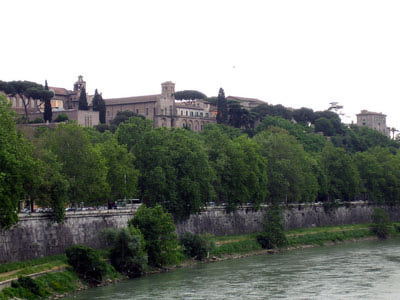
Source: Aventine and the Tiber
antmoose - Flickr Creative Commons License
Legend tells us that Remus had selected the Aventine to live on. It was there that he watched the bird omens, while his brother Romulus stood on the Palatine, each claiming the better results.
The Aventine Hill became the home of the plebeians. It was separated from the Palatine by the Circus Maximus. On the Aventine were temples to Diana, Ceres, and Libera. The Armilustrium was there, too. It was used to purify arms used in battle at the end of the military season [Mommsen]. Another significant place on the Aventine was Asinius Pollio's library.
Source: By N.S. Gill, About.com Guide

Source: Aventine and the Tiber
antmoose - Flickr Creative Commons License
Legend tells us that Remus had selected the Aventine to live on. It was there that he watched the bird omens, while his brother Romulus stood on the Palatine, each claiming the better results.
The Aventine Hill became the home of the plebeians. It was separated from the Palatine by the Circus Maximus. On the Aventine were temples to Diana, Ceres, and Libera. The Armilustrium was there, too. It was used to purify arms used in battle at the end of the military season [Mommsen]. Another significant place on the Aventine was Asinius Pollio's library.
Source: By N.S. Gill, About.com Guide
One of the Seven Hills of Rome - Capitoline
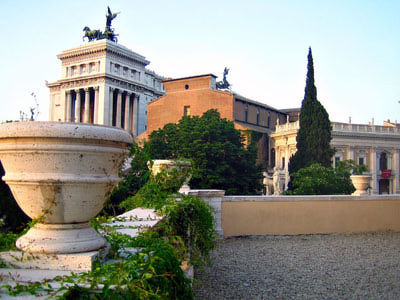
Source: Capitoline Hill
antmoose - Flickr Creative Commons License
The Capitoline is the smallest in area, 460 meters long and 180 meters wide, situated between the forum and the Campus Martius. Its name comes from the legendary human skull (caput) found buried in it (Livy I.55). It was the home to the temple of Iovis Optimi Maximi (Jupiter best and greatest), built by the Tarquin kings of Rome.
When the Gauls attacked Rome, the Capitoline did not fall because of the geese who gave warning. The temple of Juno Moneta, possibly named moneta for the warning of the geese, is also on the Capitoline. This is where coins were minted, providing the etymology for the word "money".
The assassins of Caesar locked themselves in the Temple of Capitoline Jupiter after the murder.
Criminals were dropped from the hill onto the Tarpeian crags below.
Bentley's Comment:
- Funny how the word money has its origins from Rome and the temple of Juno Moneta where the Roman coins were minted.
Source: By N.S. Gill, About.com Guide

Source: Capitoline Hill
antmoose - Flickr Creative Commons License
The Capitoline is the smallest in area, 460 meters long and 180 meters wide, situated between the forum and the Campus Martius. Its name comes from the legendary human skull (caput) found buried in it (Livy I.55). It was the home to the temple of Iovis Optimi Maximi (Jupiter best and greatest), built by the Tarquin kings of Rome.
When the Gauls attacked Rome, the Capitoline did not fall because of the geese who gave warning. The temple of Juno Moneta, possibly named moneta for the warning of the geese, is also on the Capitoline. This is where coins were minted, providing the etymology for the word "money".
The assassins of Caesar locked themselves in the Temple of Capitoline Jupiter after the murder.
Criminals were dropped from the hill onto the Tarpeian crags below.
Bentley's Comment:
- Funny how the word money has its origins from Rome and the temple of Juno Moneta where the Roman coins were minted.
Source: By N.S. Gill, About.com Guide
One of the Seven Hills of Rome - Quirinal
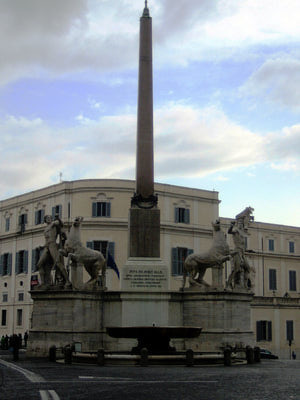
Source: Fountain of Piazza del Quirinale
antmoose - Flickr Creative Commons License
The Quirinal is the most northerly of the seven hills of Rome. The Viminal, Esquiline, and Quirinal are referred to as colles, more diminutive than montes, the term for the other hills. In early days, the Quirinal belonged to the Sabines. The second king of Rome, Numa, lived upon it. Cicero's friend Atticus also lived there.

Source: Fountain of Piazza del Quirinale
antmoose - Flickr Creative Commons License
The Quirinal is the most northerly of the seven hills of Rome. The Viminal, Esquiline, and Quirinal are referred to as colles, more diminutive than montes, the term for the other hills. In early days, the Quirinal belonged to the Sabines. The second king of Rome, Numa, lived upon it. Cicero's friend Atticus also lived there.
One of the Seven Hills of Rome - Viminal
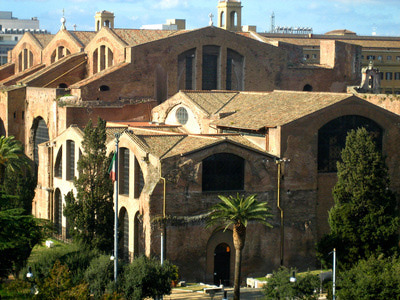
Source: Maria degli Angeli
antmoose - Flickr Creative Commons License
A small, unimportant hill, with few monuments. Caracalla's temple of Serapis was on it. To the northeast of the Viminal were the thermae Diocletiani, Baths of Diocletian, whose ruins were re-used by churches (now the Basilica of Santa Maria degli Angeli and the Museo Nazionale Romano) after the baths became unusable when the Goths cut the aqueducts in A.D. 537.
Source: By N.S. Gill, About.com Guide

Source: Maria degli Angeli
antmoose - Flickr Creative Commons License
A small, unimportant hill, with few monuments. Caracalla's temple of Serapis was on it. To the northeast of the Viminal were the thermae Diocletiani, Baths of Diocletian, whose ruins were re-used by churches (now the Basilica of Santa Maria degli Angeli and the Museo Nazionale Romano) after the baths became unusable when the Goths cut the aqueducts in A.D. 537.
Source: By N.S. Gill, About.com Guide
One of the Seven Hills of Rome - Caelian
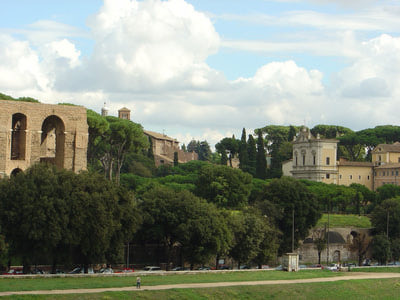
Source: Caelian
Xerones - Flicker - Creative Commons License
The Baths of Caracalla (Thermae Antoniniani) were built south of the Caelian Hill, which was the most south-easterly of the seven hills of Rome. The Caelian is described as a tongue "2 kilometres long and 400 to 500 metres wide" in A Topographical Dictionary of Ancient Rome. The Servian Wall included the western half of the Caelian in the city of Rome. During the Republic, the Caelian was densely populated. After a fire in A.D. 27, the Caelian became home to Rome's wealthy.
Source: By N.S. Gill, About.com Guide

Source: Caelian
Xerones - Flicker - Creative Commons License
The Baths of Caracalla (Thermae Antoniniani) were built south of the Caelian Hill, which was the most south-easterly of the seven hills of Rome. The Caelian is described as a tongue "2 kilometres long and 400 to 500 metres wide" in A Topographical Dictionary of Ancient Rome. The Servian Wall included the western half of the Caelian in the city of Rome. During the Republic, the Caelian was densely populated. After a fire in A.D. 27, the Caelian became home to Rome's wealthy.
Source: By N.S. Gill, About.com Guide
Quaestor
Quaestors were elected officials of the Roman Republic who supervised the treasury and financial affairs of the state, its armies and its officers. The office may date back to the time of the Kingdom of Rome. By about 420 BC there were four Quaestors, elected each year by the Comitia Tributa, and after 267 BC there were ten. Some Quaestors were assigned to work in the City, while others were assigned to the staffs of generals or served as Lieutenant governors in the provinces. Still others were assigned to oversee military finances.
Quaestors were originally appointed by the consuls to investigate criminal acts and determine whether the consul needed to take public action. They eventually became elected officials and took on additional responsibilities, such as supervising the treasury (for which they are best known). The office of Quaestor was adopted as part of the cursus honorum.
During the reforms of Sulla in 81 BC, the minimum age for a quaestorship was set at 30 for patricians and at 32 for plebeians, and election to the quaestorship gave automatic membership in the Senate. Before that, the censors revised the rolls of the Senate less regularly than the annual induction of quaestors created. The number of quaestors was also raised to 20.
During Late Antiquity, the office of quaestor sacri palatii existed, created by Constantine the Great, which functioned as the Roman Empire's senior legal official. Emperor Justinian I also created the offices of quaesitor, a judicial and police official for Constantinople, and the quaestor exercitus, a short-lived joint military-administrative post covering the border of the lower Danube. The quaestor sacri palatii survived long in the Byzantine Empire, albeit with his duties altered to coincide with those of the quaesitor. The term is last attested in Byzantium in the 14th century, as a purely honorific dignity.
Source: Wikipedia
Quaestors were elected officials of the Roman Republic who supervised the treasury and financial affairs of the state, its armies and its officers. The office may date back to the time of the Kingdom of Rome. By about 420 BC there were four Quaestors, elected each year by the Comitia Tributa, and after 267 BC there were ten. Some Quaestors were assigned to work in the City, while others were assigned to the staffs of generals or served as Lieutenant governors in the provinces. Still others were assigned to oversee military finances.
Quaestors were originally appointed by the consuls to investigate criminal acts and determine whether the consul needed to take public action. They eventually became elected officials and took on additional responsibilities, such as supervising the treasury (for which they are best known). The office of Quaestor was adopted as part of the cursus honorum.
During the reforms of Sulla in 81 BC, the minimum age for a quaestorship was set at 30 for patricians and at 32 for plebeians, and election to the quaestorship gave automatic membership in the Senate. Before that, the censors revised the rolls of the Senate less regularly than the annual induction of quaestors created. The number of quaestors was also raised to 20.
During Late Antiquity, the office of quaestor sacri palatii existed, created by Constantine the Great, which functioned as the Roman Empire's senior legal official. Emperor Justinian I also created the offices of quaesitor, a judicial and police official for Constantinople, and the quaestor exercitus, a short-lived joint military-administrative post covering the border of the lower Danube. The quaestor sacri palatii survived long in the Byzantine Empire, albeit with his duties altered to coincide with those of the quaesitor. The term is last attested in Byzantium in the 14th century, as a purely honorific dignity.
Source: Wikipedia
This site gives a very good description of all of the Roman Offices:
http://www.roman-empire.net/republic/...
Remember at the beginning of this book Caesar was a Quaestor.
http://www.roman-empire.net/republic/...
Remember at the beginning of this book Caesar was a Quaestor.
message 24:
by
Bentley, Group Founder, Leader, Chief
(last edited Apr 19, 2012 05:56PM)
(new)
-
rated it 3 stars
Marcus Calpurnius Bibulus
http://en.wikipedia.org/wiki/Marcus_C...
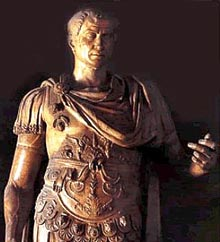
Leader of Roman nobility who tried to block Julius Caesar's rise to political power. As Caesar's co-consul in 59 BCE, Bibulus vetoed Caesar's bill designed to distribute land south of Rome to Pompey's troops. The popular Assembly reacted with mob violence, symbolically driving Bibulus from office & leaving Caesar's edicts unchecked for the rest of his term.
Bibulus was eventually able to avenge that disgrace, as the rivalry between Pompey & Caesar deepened. After the murder of Pompey's co-consul [Publius Clodius] in 52 BCE, Bibulus persuaded the Senate to allow Pompey to complete his term without choosing a peer. The following year he was rewarded with appointment as governor of Syria. Other than some tension between Roman troops in Syria and their new commander, who claimed credit for the legions' victories over the Parthians under his predecessor [Cassius], Bibulus' term in this post passed without major incident--in dramatic contrast to the political turbulence elsewhere in the Mediterranean at this time.
Early in 48 BCE he succeeded in stranding Caesar's forces in Epirus [modern Albania] by capturing his transport ships in the Adriatic. But this minor victory was erased a few months later by Caesar's crushing defeat of Pompey at Pharsalus, an event Bibulus had the misfortune of living just long enough to witness.
Source for the text above:
http://virtualreligion.net/iho/bibulu...
http://en.wikipedia.org/wiki/Marcus_C...

Leader of Roman nobility who tried to block Julius Caesar's rise to political power. As Caesar's co-consul in 59 BCE, Bibulus vetoed Caesar's bill designed to distribute land south of Rome to Pompey's troops. The popular Assembly reacted with mob violence, symbolically driving Bibulus from office & leaving Caesar's edicts unchecked for the rest of his term.
Bibulus was eventually able to avenge that disgrace, as the rivalry between Pompey & Caesar deepened. After the murder of Pompey's co-consul [Publius Clodius] in 52 BCE, Bibulus persuaded the Senate to allow Pompey to complete his term without choosing a peer. The following year he was rewarded with appointment as governor of Syria. Other than some tension between Roman troops in Syria and their new commander, who claimed credit for the legions' victories over the Parthians under his predecessor [Cassius], Bibulus' term in this post passed without major incident--in dramatic contrast to the political turbulence elsewhere in the Mediterranean at this time.
Early in 48 BCE he succeeded in stranding Caesar's forces in Epirus [modern Albania] by capturing his transport ships in the Adriatic. But this minor victory was erased a few months later by Caesar's crushing defeat of Pompey at Pharsalus, an event Bibulus had the misfortune of living just long enough to witness.
Source for the text above:
http://virtualreligion.net/iho/bibulu...
Lucius Calpurnius Bibulus
Lucius Calpurnius Bibulus (died around 32) was a Roman statesman.
Lucius Bibulus was the son of Julius Caesar's implacable enemy Marcus Calpurnius Bibulus and possibly, Porcia Catonis (daughter of Cato the Younger), although it is unlikely. His two elder brothers were killed in Egypt by some of the soldiery which Aulus Gabinius had left there after having restored Ptolemy Auletes to the throne. His father died in 48 BC from the exhaustion and strain of commanding the republican fleets against Caesar. After Caesar's murder, Lucius chose the side of Marcus Junius Brutus, Porcia's new husband, for whom he fought at the battle of Philippi. After the defeat of Caesar's murderers, he surrendered to Marcus Antonius who later gave him command of his fleet. Bibulus was later made governor of Syria by Augustus and he died around 32.
Source: Wikipedia
Lucius Calpurnius Bibulus (died around 32) was a Roman statesman.
Lucius Bibulus was the son of Julius Caesar's implacable enemy Marcus Calpurnius Bibulus and possibly, Porcia Catonis (daughter of Cato the Younger), although it is unlikely. His two elder brothers were killed in Egypt by some of the soldiery which Aulus Gabinius had left there after having restored Ptolemy Auletes to the throne. His father died in 48 BC from the exhaustion and strain of commanding the republican fleets against Caesar. After Caesar's murder, Lucius chose the side of Marcus Junius Brutus, Porcia's new husband, for whom he fought at the battle of Philippi. After the defeat of Caesar's murderers, he surrendered to Marcus Antonius who later gave him command of his fleet. Bibulus was later made governor of Syria by Augustus and he died around 32.
Source: Wikipedia
message 26:
by
Bentley, Group Founder, Leader, Chief
(last edited Apr 19, 2012 08:07PM)
(new)
-
rated it 3 stars
Lucius Cornelius Balbus (called Major - the Elder
Lucius Cornelius Balbus (called Major - the Elder - to distinguish him from his nephew) was born in Gades early in the last century BC.
He served under Quintus Caecilius Metellus Pius and Pompey against Sertorius in Hispania (the Iberian Peninsula, comprising modern Spain, Andorra, Gibraltar and Portugal). For his services against Sertorius the Roman citizenship was conferred upon him and his family by Pompey. He accompanied Pompey on his return to Rome, 71 BC, and was for a long time one of his most intimate friends.
At the same time he gained the friendship of Julius Caesar, who placed great confidence in him. Becoming friendly with all parties, he had much to do with the formation of the First Triumvirate, and was one of the chief financiers in Rome. He was careful to ingratiate himself with Caesar, whom he accompanied when propraetor to Hispania (61 BC), and to Gaul (58 BC) as chief engineer (praefectus fabrum).
His position as a naturalized foreigner, his influence and his wealth naturally made Balbus many enemies, who in 56 BC put up a native of Gades to prosecute him for illegally assuming the rights of a Roman citizen, a charge directed against the triumvirs equally with himself. Cicero (whose speech has been preserved), Pompey and Crassus all spoke on his behalf, and he was acquitted. During the civil war, 49 BC Balbus did not take any open part against Pompey.
He endeavoured to get Cicero to mediate between Caesar and Pompey, with the object of preventing him from definitely siding with the latter; and Cicero admits that he was dissuaded from doing so, against his better judgment.
Balbus attached himself to Caesar, and, in conjunction with Oppius, had the entire management of Caesar's affairs at Rome. Subsequently, Balbus became Caesar's private secretary, and Cicero was obliged to ask for his good offices with Caesar.
After Caesar's murder 44 BC, Balbus was equally successful in gaining the favour of Octavian; in 43 BC or 42 BC he was praetor, and in 40 BC he became the first naturalised Roman citizen to attain the consulship.[3] The year of his death is not known.
Balbus kept a diary of the chief events in his own and Caesar's life (Ephemeris), which has been lost (Suetonius, Caesar, 81). He took care that Caesar's Commentaries on the Gallic war should be continued; and accordingly the 8th book of the Commentarii de Bello Gallico (which was probably written by his friend Hirtius at his instigation) is dedicated to him.
Source: Wikipedia
http://en.wikipedia.org/wiki/Lucius_C...
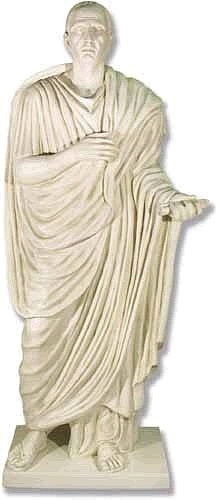
Lucius Cornelius Balbus (called Major - the Elder - to distinguish him from his nephew) was born in Gades early in the last century BC.
He served under Quintus Caecilius Metellus Pius and Pompey against Sertorius in Hispania (the Iberian Peninsula, comprising modern Spain, Andorra, Gibraltar and Portugal). For his services against Sertorius the Roman citizenship was conferred upon him and his family by Pompey. He accompanied Pompey on his return to Rome, 71 BC, and was for a long time one of his most intimate friends.
At the same time he gained the friendship of Julius Caesar, who placed great confidence in him. Becoming friendly with all parties, he had much to do with the formation of the First Triumvirate, and was one of the chief financiers in Rome. He was careful to ingratiate himself with Caesar, whom he accompanied when propraetor to Hispania (61 BC), and to Gaul (58 BC) as chief engineer (praefectus fabrum).
His position as a naturalized foreigner, his influence and his wealth naturally made Balbus many enemies, who in 56 BC put up a native of Gades to prosecute him for illegally assuming the rights of a Roman citizen, a charge directed against the triumvirs equally with himself. Cicero (whose speech has been preserved), Pompey and Crassus all spoke on his behalf, and he was acquitted. During the civil war, 49 BC Balbus did not take any open part against Pompey.
He endeavoured to get Cicero to mediate between Caesar and Pompey, with the object of preventing him from definitely siding with the latter; and Cicero admits that he was dissuaded from doing so, against his better judgment.
Balbus attached himself to Caesar, and, in conjunction with Oppius, had the entire management of Caesar's affairs at Rome. Subsequently, Balbus became Caesar's private secretary, and Cicero was obliged to ask for his good offices with Caesar.
After Caesar's murder 44 BC, Balbus was equally successful in gaining the favour of Octavian; in 43 BC or 42 BC he was praetor, and in 40 BC he became the first naturalised Roman citizen to attain the consulship.[3] The year of his death is not known.
Balbus kept a diary of the chief events in his own and Caesar's life (Ephemeris), which has been lost (Suetonius, Caesar, 81). He took care that Caesar's Commentaries on the Gallic war should be continued; and accordingly the 8th book of the Commentarii de Bello Gallico (which was probably written by his friend Hirtius at his instigation) is dedicated to him.
Source: Wikipedia
http://en.wikipedia.org/wiki/Lucius_C...

message 27:
by
Bentley, Group Founder, Leader, Chief
(last edited Apr 19, 2012 08:01PM)
(new)
-
rated it 3 stars
Lucius Cornelius Balbus (called Minor - the Younger - to distinguish from his uncle), received Roman citizenship at the same time as his uncle.
During the civil war, he served under Julius Caesar, by whom he was entrusted with several important missions. He also took part in the Alexandrian and Spanish wars. He was rewarded for his services by being admitted into the college of pontiffs.
In 43 BC he was quaestor to Asinius Pollio in Further Spain (Hispania Ulterior), where he amassed a large fortune by plundering the inhabitants. Also, while there added to his native town, Gades, a suburb.
In the same year he crossed over to Bogud, king of Mauretania, and is not heard of again until 21 BC, when he appears as Proconsul of Africa. Mommsen thinks that he had incurred the displeasure of Augustus by his conduct as praetor, and that his African appointment after so many years was due to his exceptional fitness for the post.
In 19 BC Balbus defeated the Garamantes, and on March 27 in that year received the honor of a triumph, which was then for the first time granted to one who was not a Roman citizen by birth, and for the last time to a private individual, until the triumph of Belisarius in 534. He built a magnificent theatre at Rome, which was dedicated on the return of Augustus from Gaul in 13 BC
Balbus appears to have given some attention to literature. He wrote a play of which the subject was his visit to Lentulus in the camp of Pompey at Dyrrhachium, and, according to Macrobius,[3] was the author of a work called Ἐχηγητικά (Exegetica) dealing with the gods and their worship.
Source: Wikipedia
http://en.wikipedia.org/wiki/Lucius_C...

Balbus "The Minor"'s statue, placed in Cadiz, Andalusia, Spain.
During the civil war, he served under Julius Caesar, by whom he was entrusted with several important missions. He also took part in the Alexandrian and Spanish wars. He was rewarded for his services by being admitted into the college of pontiffs.
In 43 BC he was quaestor to Asinius Pollio in Further Spain (Hispania Ulterior), where he amassed a large fortune by plundering the inhabitants. Also, while there added to his native town, Gades, a suburb.
In the same year he crossed over to Bogud, king of Mauretania, and is not heard of again until 21 BC, when he appears as Proconsul of Africa. Mommsen thinks that he had incurred the displeasure of Augustus by his conduct as praetor, and that his African appointment after so many years was due to his exceptional fitness for the post.
In 19 BC Balbus defeated the Garamantes, and on March 27 in that year received the honor of a triumph, which was then for the first time granted to one who was not a Roman citizen by birth, and for the last time to a private individual, until the triumph of Belisarius in 534. He built a magnificent theatre at Rome, which was dedicated on the return of Augustus from Gaul in 13 BC
Balbus appears to have given some attention to literature. He wrote a play of which the subject was his visit to Lentulus in the camp of Pompey at Dyrrhachium, and, according to Macrobius,[3] was the author of a work called Ἐχηγητικά (Exegetica) dealing with the gods and their worship.
Source: Wikipedia
http://en.wikipedia.org/wiki/Lucius_C...

Balbus "The Minor"'s statue, placed in Cadiz, Andalusia, Spain.
message 28:
by
Bentley, Group Founder, Leader, Chief
(last edited Apr 19, 2012 08:27PM)
(new)
-
rated it 3 stars
Cato the Younger
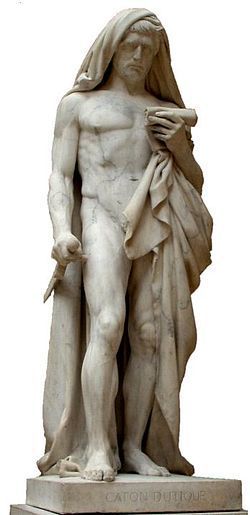
Cato the Younger, so called to distinguish him from his famous great-grandfather Cato the Elder, was one of the most fascinating figures of the Late Roman Republic. Cato was a politician, a follower of the Stoic philosophy, and a man renowned for his legendary unyielding nature. He was reputed to be immune to bribes, a paragon of virtue, and possessed of a character that could not abide corruption or graft. For all this, however, it is also arguable that Cato’s legendary stubbornness actually created the conditions that led to the eventual fall of the Republic, as Cato’s unwillingness to compromise in any particular would leave Julius Caesar little choice but to cross the Rubicon. Cato’s extreme character may perhaps best serve as a reminder that, as Friedrich Nietzsche noted, “Extreme positions are not succeeded by moderate ones, but by contrary extreme positions.” As the Republic spiraled ever more out of control, Cato played a powerful role in ensuring that neither side would have any room to compromise.
Source:
http://antiquitatis.com/rome/biograph...
http://en.wikipedia.org/wiki/Cato_the...

Cato the Younger, so called to distinguish him from his famous great-grandfather Cato the Elder, was one of the most fascinating figures of the Late Roman Republic. Cato was a politician, a follower of the Stoic philosophy, and a man renowned for his legendary unyielding nature. He was reputed to be immune to bribes, a paragon of virtue, and possessed of a character that could not abide corruption or graft. For all this, however, it is also arguable that Cato’s legendary stubbornness actually created the conditions that led to the eventual fall of the Republic, as Cato’s unwillingness to compromise in any particular would leave Julius Caesar little choice but to cross the Rubicon. Cato’s extreme character may perhaps best serve as a reminder that, as Friedrich Nietzsche noted, “Extreme positions are not succeeded by moderate ones, but by contrary extreme positions.” As the Republic spiraled ever more out of control, Cato played a powerful role in ensuring that neither side would have any room to compromise.
Source:
http://antiquitatis.com/rome/biograph...
http://en.wikipedia.org/wiki/Cato_the...
Cato the Elder - Marcus Porcius Cato
http://en.wikipedia.org/wiki/Cato_the...
Marcus Porcius Cato (234 BC, Tusculum – 149 BC) was a Roman statesman, commonly referred to as Censorius (the Censor), Sapiens (the Wise), Priscus (the Ancient), or Major, Cato the Elder, or Cato the Censor, to distinguish him from his great-grandson, Cato the Younger.
He came of an ancient Plebeian family who all were noted for some military service but not for the discharge of the higher civil offices. He was bred, after the manner of his Latin forefathers, to agriculture, to which he devoted himself when not engaged in military service. But, having attracted the notice of Lucius Valerius Flaccus, he was brought to Rome, and successively held the offices of Cursus Honorum: Military tribune (214 BC), Quaestor (204 BC), Aedile (199 BC), Praetor (198 BC), Consul (195 BC) together with his old patron, and finally Censor (184 BC).
Cato the Elder was also an ancestor of Nero, who was one of the most notorious Roman Emperors
[image error]
http://en.wikipedia.org/wiki/Cato_the...
Marcus Porcius Cato (234 BC, Tusculum – 149 BC) was a Roman statesman, commonly referred to as Censorius (the Censor), Sapiens (the Wise), Priscus (the Ancient), or Major, Cato the Elder, or Cato the Censor, to distinguish him from his great-grandson, Cato the Younger.
He came of an ancient Plebeian family who all were noted for some military service but not for the discharge of the higher civil offices. He was bred, after the manner of his Latin forefathers, to agriculture, to which he devoted himself when not engaged in military service. But, having attracted the notice of Lucius Valerius Flaccus, he was brought to Rome, and successively held the offices of Cursus Honorum: Military tribune (214 BC), Quaestor (204 BC), Aedile (199 BC), Praetor (198 BC), Consul (195 BC) together with his old patron, and finally Censor (184 BC).
Cato the Elder was also an ancestor of Nero, who was one of the most notorious Roman Emperors
[image error]
Julia (gens)
The gens Julia was one of the most ancient patrician families at Ancient Rome. Members of the gens attained the highest dignities of the state in the earliest times of the Republic. The first of the family to obtain the consulship was Gaius Julius Iulus in 489 BC. The gens is perhaps best known, however, for Gaius Julius Caesar, the dictator, and grand uncle of the emperor Augustus, through whom the name was passed to the so-called Julio-Claudian dynasty of the 1st century AD. The nomen Julius became quite common in imperial times, as the descendants of persons enrolled as citizens under the early emperors began to make their mark in history.
Source: Wikipedia
http://en.wikipedia.org/wiki/Julia_(g...
The gens Julia was one of the most ancient patrician families at Ancient Rome. Members of the gens attained the highest dignities of the state in the earliest times of the Republic. The first of the family to obtain the consulship was Gaius Julius Iulus in 489 BC. The gens is perhaps best known, however, for Gaius Julius Caesar, the dictator, and grand uncle of the emperor Augustus, through whom the name was passed to the so-called Julio-Claudian dynasty of the 1st century AD. The nomen Julius became quite common in imperial times, as the descendants of persons enrolled as citizens under the early emperors began to make their mark in history.
Source: Wikipedia
http://en.wikipedia.org/wiki/Julia_(g...
message 31:
by
Bentley, Group Founder, Leader, Chief
(last edited Apr 19, 2012 08:44PM)
(new)
-
rated it 3 stars
Gaius Julius Caesar (proconsul) - father of Julius Caesar
Gaius Julius Caesar (ca. 140 BC–85 BC) was a Roman senator, supporter and brother-in-law of Gaius Marius, and father of Julius Caesar, the later dictator of Rome.
Caesar was married to Aurelia Cotta, a member of the Aurelii and Rutilii families, and had two daughters, both named Julia as was common in Rome, and a son, Julius Caesar, born in 100 BC.
He was the brother of Sextus Julius Caesar, consul in 91 BC[2] and the son of Gaius Julius Caesar.
Caesar's progress through the cursus honorum is well known, although the specific dates associated with his offices are controversial. According to two elogia erected in Rome long after his death, Caesar was a commissioner in the colony at Cercina, military tribune, quaestor, praetor, and proconsul of Asia.
The dates of these offices are unclear. The colony is probably one of Marius' of 103 BC.
Broughton dated the praetorship to 92 BC, with the quaestorship falling towards the beginning of the 90s.
Brennan has dated the praetorship to the beginning of the decade.
Caesar died suddenly in 85 BC, in Rome, while putting on his shoes one morning. Another Caesar, possibly his father, had died similarly in Pisa.
His father had seen to his education by one of the best orators of Rome, Marcus Antonius Gnipho.
In his will, he left Caesar the bulk of his estate, but after Marius's faction had been defeated in the civil war of the 80s BC, this inheritance was confiscated by the dictator Sulla.
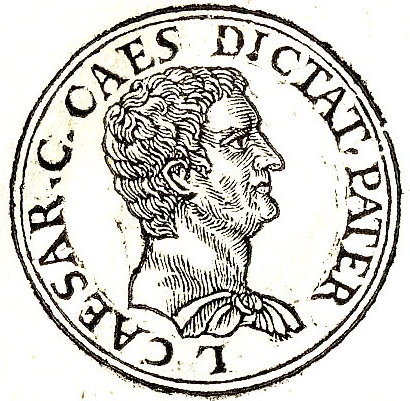
Gaius Julius Caesar (proconsul of Asia) was a Roman senator, supporter and brother-in-law of Gaius Marius, and father of Julius Caesar, the later dictator of Rome.
Source: Wikipedia
Gaius Julius Caesar (ca. 140 BC–85 BC) was a Roman senator, supporter and brother-in-law of Gaius Marius, and father of Julius Caesar, the later dictator of Rome.
Caesar was married to Aurelia Cotta, a member of the Aurelii and Rutilii families, and had two daughters, both named Julia as was common in Rome, and a son, Julius Caesar, born in 100 BC.
He was the brother of Sextus Julius Caesar, consul in 91 BC[2] and the son of Gaius Julius Caesar.
Caesar's progress through the cursus honorum is well known, although the specific dates associated with his offices are controversial. According to two elogia erected in Rome long after his death, Caesar was a commissioner in the colony at Cercina, military tribune, quaestor, praetor, and proconsul of Asia.
The dates of these offices are unclear. The colony is probably one of Marius' of 103 BC.
Broughton dated the praetorship to 92 BC, with the quaestorship falling towards the beginning of the 90s.
Brennan has dated the praetorship to the beginning of the decade.
Caesar died suddenly in 85 BC, in Rome, while putting on his shoes one morning. Another Caesar, possibly his father, had died similarly in Pisa.
His father had seen to his education by one of the best orators of Rome, Marcus Antonius Gnipho.
In his will, he left Caesar the bulk of his estate, but after Marius's faction had been defeated in the civil war of the 80s BC, this inheritance was confiscated by the dictator Sulla.

Gaius Julius Caesar (proconsul of Asia) was a Roman senator, supporter and brother-in-law of Gaius Marius, and father of Julius Caesar, the later dictator of Rome.
Source: Wikipedia
message 32:
by
Bentley, Group Founder, Leader, Chief
(last edited Apr 19, 2012 09:39PM)
(new)
-
rated it 3 stars
Marcus Licinius Crassus
Marcus Licinius Crassus (Latin: M·LICINIVS·P·F·P·N·CRASSVS[1]) (ca. 115 BCE – 53 BCE) was a Roman general and politician who commanded the right wing of Sulla's army at the Battle of the Colline Gate, suppressed the slave revolt led by Spartacus, provided political and financial support to Julius Caesar and entered into the political alliance known as the First Triumvirate with Pompey and Julius Caesar. At the height of his fortune he was allegedly worth more than 200,000,000 sestertii. He is considered the wealthiest man in Roman history, and perhaps one of the richest men in all history. Crassus nonetheless desired recognition for his military victories; this ambition for acclaim eventually led him into Syria, where he was defeated and killed in the Roman defeat at Carrhae against a Parthian Spahbod (General) named Surena.
Source : Wikipedia
http://en.wikipedia.org/wiki/Marcus_L...
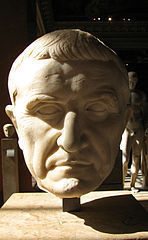
Marcus Licinius Crassus (Latin: M·LICINIVS·P·F·P·N·CRASSVS[1]) (ca. 115 BCE – 53 BCE) was a Roman general and politician who commanded the right wing of Sulla's army at the Battle of the Colline Gate, suppressed the slave revolt led by Spartacus, provided political and financial support to Julius Caesar and entered into the political alliance known as the First Triumvirate with Pompey and Julius Caesar. At the height of his fortune he was allegedly worth more than 200,000,000 sestertii. He is considered the wealthiest man in Roman history, and perhaps one of the richest men in all history. Crassus nonetheless desired recognition for his military victories; this ambition for acclaim eventually led him into Syria, where he was defeated and killed in the Roman defeat at Carrhae against a Parthian Spahbod (General) named Surena.
Source : Wikipedia
http://en.wikipedia.org/wiki/Marcus_L...

message 33:
by
Bentley, Group Founder, Leader, Chief
(last edited Apr 19, 2012 09:45PM)
(new)
-
rated it 3 stars
Pompey
Gnaeus Pompeius Magnus, also known as Pompey ( /ˈpɒmpiː/) or Pompey the Great[1] (Classical Latin abbreviation: CN·POMPEIVS·CN·F·SEX·N·MAGNVS; September 29, 106 BC – September 29, 48 BC), was a military and political leader of the late Roman Republic. He came from a wealthy Italian provincial background, and established himself in the ranks of Roman nobility by successful leadership in several military campaigns. Sulla addressed him by the cognomen Magnus (the Great), and he was awarded three triumphs.
Pompey joined his rival Marcus Licinius Crassus and his ally Julius Ceasar in the unofficial military-political alliance known as the First Triumvirate. The first triumvirate was validated by the marriage between Julia Caesar (daughter of Julius Caesar) and Pompey. After the deaths of Julia and Crassus, Pompey sided with the optimates, the conservative and aristocratic faction of the Roman Senate. Pompey and Caesar contended for the leadership of the Roman state, leading to a civil war. When Pompey was defeated at the Battle of Pharsalus, he sought refuge in Egypt, where he was assassinated. His career and defeat are significant in Rome's subsequent transformation from Republic to Principate and Empire.
Source: Wikipedia
http://en.wikipedia.org/wiki/Pompey
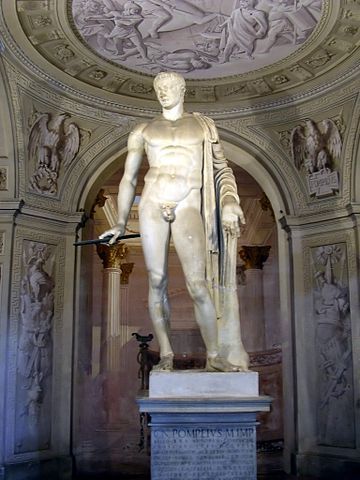
Roman statue of Pompey. It is now in Villa Arconati a Castellazzo di Bollate (Milan, Italy). It was brought there from Rome in 1627 by Galeazzo Arconati. The left hand and the metal parts are not original, but later additions and repairs. It is handed down that Julius Caesar was killed at the feet of this statue.

Pompey the Great in Middle Age
Gnaeus Pompeius Magnus, also known as Pompey ( /ˈpɒmpiː/) or Pompey the Great[1] (Classical Latin abbreviation: CN·POMPEIVS·CN·F·SEX·N·MAGNVS; September 29, 106 BC – September 29, 48 BC), was a military and political leader of the late Roman Republic. He came from a wealthy Italian provincial background, and established himself in the ranks of Roman nobility by successful leadership in several military campaigns. Sulla addressed him by the cognomen Magnus (the Great), and he was awarded three triumphs.
Pompey joined his rival Marcus Licinius Crassus and his ally Julius Ceasar in the unofficial military-political alliance known as the First Triumvirate. The first triumvirate was validated by the marriage between Julia Caesar (daughter of Julius Caesar) and Pompey. After the deaths of Julia and Crassus, Pompey sided with the optimates, the conservative and aristocratic faction of the Roman Senate. Pompey and Caesar contended for the leadership of the Roman state, leading to a civil war. When Pompey was defeated at the Battle of Pharsalus, he sought refuge in Egypt, where he was assassinated. His career and defeat are significant in Rome's subsequent transformation from Republic to Principate and Empire.
Source: Wikipedia
http://en.wikipedia.org/wiki/Pompey

Roman statue of Pompey. It is now in Villa Arconati a Castellazzo di Bollate (Milan, Italy). It was brought there from Rome in 1627 by Galeazzo Arconati. The left hand and the metal parts are not original, but later additions and repairs. It is handed down that Julius Caesar was killed at the feet of this statue.

Pompey the Great in Middle Age
 To provide historical background to those new to the series, the next few posts will contain information from the History Book Club glossary for the first book in the series, The First Man in Rome.
To provide historical background to those new to the series, the next few posts will contain information from the History Book Club glossary for the first book in the series, The First Man in Rome. by
by
 Colleen McCullough
Colleen McCullough
 Julius Caesar
Julius Caesar[image error]
"Tusculum", possibly the only surviving bust of Julius Caesar dating from his lifetime
The following Wikipedia article contains comprehensive information on Julius Caesar, part of which may contain spoilers for the current book.
http://en.wikipedia.org/wiki/Julius_C...
The article also contains this interesting family tree:

There is also a separate Wikipedia article on the Julio-Claudian family tree, with links to articles to almost all members of the family here:
http://en.wikipedia.org/wiki/Julio-Cl...
 What did Auctoritas mean to the Julians? It is defined in the glossary as "a very difficult Latin term to translate, as it means much more than the English word "authority." It carried implications of pre-eminence, clout, leadership, public and private importance, and - above all - the ability to influence events through sheer public or personal reputation. All the magistracies possessed auctoritas as part of their nature, but auctoritas was not confined to those who held magistracies: the Princeps Senatus, Pontifex Maximus, Rex Sacrorum, consulars, and even some private individuals could also accumulate auctoritas."
What did Auctoritas mean to the Julians? It is defined in the glossary as "a very difficult Latin term to translate, as it means much more than the English word "authority." It carried implications of pre-eminence, clout, leadership, public and private importance, and - above all - the ability to influence events through sheer public or personal reputation. All the magistracies possessed auctoritas as part of their nature, but auctoritas was not confined to those who held magistracies: the Princeps Senatus, Pontifex Maximus, Rex Sacrorum, consulars, and even some private individuals could also accumulate auctoritas."During the days of the Roman Empire, the Emperor had the title of princeps ("first citizen" of Rome) and held the auctoritas principis — the supreme moral authority — in conjunction with the imperium and potestas — the military, judiciary and administrative powers.
Here is a Wikipedia article on auctoritas:
http://en.wikipedia.org/wiki/Auctoritas
 Lucius Cornelius Sulla (c. 138 BC – 78 BC), commonly known as Sulla, was the grandfather of Julius Caesar's wife Pompeia. He had the rare distinction of holding the office of consul twice as well as the dictatorship. He was one of the canonical great men of Roman history; included in the biographical collections of leading generals and politicians, originating in the biographical compendium of famous Romans, published by Marcus Terentius Varro. In Plutarch's famous series - Parallel Lives, Sulla is paired with the Spartan general and strategist Lysander.
Lucius Cornelius Sulla (c. 138 BC – 78 BC), commonly known as Sulla, was the grandfather of Julius Caesar's wife Pompeia. He had the rare distinction of holding the office of consul twice as well as the dictatorship. He was one of the canonical great men of Roman history; included in the biographical collections of leading generals and politicians, originating in the biographical compendium of famous Romans, published by Marcus Terentius Varro. In Plutarch's famous series - Parallel Lives, Sulla is paired with the Spartan general and strategist Lysander.Sulla's dictatorship came during a high point in the struggle between optimates and populares, the former seeking to maintain the power of the oligarchy in the form of the Senate while the latter resorted in many cases to naked populism, culminating in Caesar's dictatorship. Sulla was a highly original, gifted and skillful general, never losing a battle; he remains the only man in history to have attacked and occupied both Athens and Rome. His rival, Gnaeus Papirius Carbo, described Sulla as having the cunning of a fox and the courage of a lion - but that it was the former attribute that was by far the most dangerous. This mixture was later referred to by Machiavelli in his description of the ideal characteristics of a ruler.
Sulla used his armies to march on Rome twice, and after the second he revived the office of dictator, which had not been used since the Second Punic War over a century before. He used his powers to enact a series of reforms to the Roman constitution, meant to restore the balance of power between the Senate and the Tribunes; he then stunned the Roman World (and posterity) by resigning the dictatorship, restoring normal constitutional government, and after his second Consulship, retiring to private life.
Early years
Sulla was born into a branch of the patrician gens Cornelia, but his family had fallen to an impoverished condition at the time of his birth. Lacking ready money, Sulla spent his youth amongst Rome’s comics, actors, lute-players, and dancers. Sulla retained an attachment to the debauched nature of his youth until the end of his life, Plutarch mentions that during his last marriage – to Valeria – he still kept company with "actresses, musicians, and dancers, drinking with them on couches night and day".
It seems certain that Sulla received a good education. Sallust declares him well-read and intelligent, and he was fluent in Greek, which was a sign of education in Rome. The means by which Sulla attained the fortune which later would enable him to ascend the ladder of Roman politics, the Cursus honorum, are not clear, although Plutarch refers to two inheritances; one from his stepmother and the other from a low-born, but rich, unmarried lady.
Wikipedia article: http://en.wikipedia.org/wiki/Lucius_C...
 by G.P. Baker(no photo)
by G.P. Baker(no photo)Plutarch's Lives (no cover) by
 Plutarch
Plutarch
Sulla
 Gaius Marius (157 BC–January 13, 86 BC) was Julius Caesar's uncle by marriage. He was elected consul an unprecedented seven times during his career. He was also noted for his dramatic reforms of Roman armies, authorizing recruitment of landless citizens, eliminated the manipular military formations, and reorganizing the structure of the legions into separate cohorts.
Gaius Marius (157 BC–January 13, 86 BC) was Julius Caesar's uncle by marriage. He was elected consul an unprecedented seven times during his career. He was also noted for his dramatic reforms of Roman armies, authorizing recruitment of landless citizens, eliminated the manipular military formations, and reorganizing the structure of the legions into separate cohorts.Early career
Marius was born in 157 BC in the town of Arpinum in southern Latium. The town had been conquered by the Romans in the late fourth century BC and was given Roman citizenship without voting rights. Only in 188 BC did the town receive full citizenship. Although Plutarch claims that Marius' father was a laborer, this is almost certainly false since Marius had connections with the nobility in Rome, he ran for local office in Arpinum, and he had marriage relations with the local nobility in Arpinum, which all combine to indicate that he was born into a locally important family of equestrian status. The problems he faced in his early career in Rome show the difficulties that faced a "new man" (novus homo).
There is a legend that Marius, as a teenager, found an eagle's nest with seven chicks in it – eagle clutches hardly ever have more than 3 eggs; even if two females used the same nest, finding 7 offspring in a single nest would be exceptionally rare. Since eagles were considered sacred animals of Jupiter, the supreme god of the Romans, it was later seen as an omen predicting his election to the consulship seven times. Later, as consul, he decreed that the eagle would be the symbol of the Senate and People of Rome.
In 134 BC, he was serving with the army at Numantia and his good services brought him to the attention of Publius Cornelius Scipio Aemilianus Africanus. Whether he arrived with Scipio Aemilianus or was already serving in the demoralized army that Scipio Aemilianus took over at Numantia is not clear. It would seem that even at this early stage in his army career, Marius had ambitions for a political career in Rome. He ran for election as one of the twenty-four special military tribunes of the first four legions who were elected (the rest were appointed by the magistrate who raised the legion). Sallust tells us that he was unknown by sight to the electors but was returned by all the tribes on the basis of his accomplishments.
Next, he ran for the quaestorship after losing an election for local office in Arpinum. The military tribunate shows that he was already interested in Roman politics before the quaestorship. Perhaps he simply ran for local office as a means of gaining support back home, and lost to some other local worthy. Nothing is known of his actions while quaestor.
In 120 BC, Marius was returned as plebian tribune for the following year. He won with the support of Quintus Caecilius Metellus (later known as Metellus Numidicus), who was an inherited patronus. The Metelli, though neither ancient nor patrician, were one of the most powerful families in Rome at this time. During his tribunate, Marius pursued a populares line. He passed a law that restricted the interference of the wealthy in elections. In the 130s voting by ballot had been introduced in elections for choosing magistrates, passing laws and deciding legal cases, replacing the earlier system of oral voting. The wealthy continued to try to influence the voting by inspecting ballots and Marius passed a law narrowing the passages down which voters passed to cast their votes in order to prevent outsiders from harassing the electors. In the passage of this law, Marius alienated the Metelli, who opposed it.
Soon thereafter, Marius ran for the aedileship and lost. This loss was at least in part due to the enmity of the Metelli. In 116 BC he barely won election as praetor for the following year (presumably coming in sixth) and was promptly accused of ambitus (electoral corruption). He barely won acquittal on this charge, and spent an uneventful year as praetor in Rome (as Urban Praetor, Peregrine Praetor or President of the extortion court). In 114 BC, Marius' imperium was prorogued and he was sent to govern Lusitania, where he engaged in some sort of minor military operation. During this period in Roman history governors seem regularly to have served two years in Hispania, so he was probably replaced in 113 BC.
He received no triumph on his return and did not apparently run for the consulship, but he did marry Julia, the aunt of Julius Caesar. The Julii Caesares were a patrician family, but at this period seem to have found it hard to advance above the praetorship. (Only once in the second century – in 157 BC – did a member of the family become consul.) To judge by this marriage, Marius had apparently achieved some substantial political or financial influence by this point (possibly from his governship in Hispania).
Wikipedia article:
http://en.wikipedia.org/wiki/Gaius_Ma...
Sallust (no photo)

Gaius Marius
 Many thanks to Alisa for these definitions of roles and responsibilities in the early Roman Republic!
Many thanks to Alisa for these definitions of roles and responsibilities in the early Roman Republic!client: The term denoted a man of free or freed status (he did not have to be a Roman citizen, however) who pledge himself to a man he called his patron. The client undertook in the most solemn and morally binding way to serve the interests and obey the wishes of his patron, in return for various favors (these were usually gifts of money, or positions, or legal assistance.) The freed slave was automatically the client of his former master, until discharged of this obligation - if he ever was. A kind of honor system governed a client's conduct in respect of his patron, and was remarkably consistently adhered to. To be a client did not necessarily mean a man could not also be a patron; more that he could not be an ultimate patron, for his own clients technically were the clients of this patron also. There were laws governing the foreign client-patron relationship; concerning foreign client-kingdoms or states owning Rome as a patron, there was a legal obligation to ransom any kidnapped Roman citizen, a fact that pirates relied on heavily as an additional source of income. Thus, not only individuals could become clients; whole towns and even countries could be clients.
plebeian, plebs: All those Roman citizens who were not patricians were plebeians - that is, they belonged to the plebs. At the beginning of the Republic, no plebeian could be a priest, a curule magistrate, or even a senator. This situation lasted only a very short while; one by one the exclusively patrician institutions crumbled before the onslaught of the plebs, until by the time of Gaius Marius only a very few politically unimportant posts remained the province of the patricians. However, the plebs created a new nobility to distinguish the stars in its firmament from the rest, by calling a man who had attained the consulship a nobilis (nobleman), and obtaining that his direct descendants would also be noble.
praetor peregrinus: ...translated as 'foreign praetor," because he dealt only with legal matters and lawsuits where at least one of the parties was not a Roman citizen. by the time of Gaius Marius, his duties were confined to the dispensation of justice; they took him all over Italy, and sometimes further afield than that. He was also responsible for looking after cases involving noncitizens with the city of Rome.
praetor urbanus: . . . translates as 'urban praetor." By the time of Gaius Marius his duties were almost purely in litigation, and he was responsible for eh supervision of justice and the law courts within the city of Rome. His imperium did not extend beyond the fifth milestone from Rome, and he was not allowed to leave Rome for more than ten days at a time. If both the consuls were absent from ROme, he was its senior magistrate and was empowered to summon the Senate to a meeting, as well as to organize the defense of the city if in danger of an attack. It was his decision whether two litigants might proceed to court; in most cases, he decided the matter there and then, without the benefit of the full legal trial process.
paterfamilias: The head of the family unit. His right to do as he pleased with the members of his family unit was rigidly protected by the laws of the Roman State.
 Shannon recommended the following book for a description of daily life in Imperial Rome.
Shannon recommended the following book for a description of daily life in Imperial Rome. by
by
 Alberto Angela
Alberto Angela
 Roman Naming Conventions
Roman Naming ConventionsBy the Republican era and throughout the Imperial era, a name in ancient Rome for a male citizen comprised three parts (tria nomina): praenomen (given name), nomen (or nomen gentile or simply gentilicium, being the name of the gens or clan) and cognomen (name of a family line within the gens). Sometimes a second or third cognomen, called agnomen, was added. The nomen, and later, cognomen were virtually always hereditary.
Females were officially known by the feminine form of their father's nomen gentile, followed by the genitive case of their father's (husband's if married) cognomen and an indication of order among sisters. By the late Roman Republic, women sometimes also adopted the feminine of their father's cognomen. A woman usually did not have the praenomen and agnomen, unless the parents chose to give her those.
For additional details on the Roman system of family names, see this Wikipedia Article:
http://en.wikipedia.org/wiki/Roman_na...
The glossary in The First Man in Rome gives the following additional information:
The glossary in the book gives us this description:
"cognomen, cognomina (pl.) The last name of a Roman male anxious to distinguish himself from all his fellows having the same first and gentilicial (family) names. In some families it became necessary to have more than one cognomen; for example, take Quintus Caecilius Metellus Pius Scipio Nasica! The cognomen usually pointed out some physical or character idiosyncrasy - jug ears or flat feet or a humpback - or else commemorated some great feat, as in the Caecilii Metelli who were cognominated Dalmaticus, Balearicus, Numidicus. Many cognomina were heavily sarcastic or extremely witty."
 by
by
 Colleen McCullough
Colleen McCullough
 Here is an excellent website for information on ancient Greece and Rome:
Here is an excellent website for information on ancient Greece and Rome: http://www.classicsunveiled.com/index...
The "Rome Exposed" section contains a lot of good information on daily life in Rome. This section includes information on the attire of boys and men, including the toga:
http://www.classicsunveiled.com/romel...
"The clothing of the Romans was simple. They usually wore 2-3 articles of clothing not including shoes. All the garments varied in material and name from time to time. There was little change in style during the late empire and early empire. Early contact with the Greeks on the south and with the Etruscans on the north gave the Romans a taste for beauty that was expressed in the grace of their flowing robes.
Clothing for men and women were very similar. Roman writers assigned each article of clothing into two classes according to how it was worn. One was indutus (put on), that was considered under garments. (Underwear) The other was called amictus (wrapped around), that was outer garments.
Underwear
The closest article of clothing was called a subligaculum, which in modern terms means a pair of shorts or a loincloth. It is said to have been the only undergarment in early times. The family of the Cethegi who wore a toga over a subligaculum continued this practice throughout the Republic. Candidates for public office and men, who wished to pose as champions of old-fashioned simplicity, wore a subligaculum. At (best times) the subligaculum was worn under a tunic or was replaced by it.
There was no regular underwear like we have today. Old men in poor health wound strips of woolen cloth like spiral puttees around their legs for warmth, or wore wraps or mufflers, but such things were considered marks of old age or weakness, not to be used by healthy men.
No Trousers
Originally, Romans had no trousers, but later they adopted one for riding and hunting. It was called the Gallic bracae. It resembled riding breeches. Sometimes Roman soldiers stationed in the north wore bracae for warmth.
Tunics
Tunics were adopted in early times and became the chief garment in the indutus class. (Undergarments) It was a plain woolen shirt made of two pieces, back and front, sewed together at the sides and on the shoulders. Openings were left for the arms and the head. The cloth extending beyond the shoulders formed sleeves, but these were usually short, not quite covering the upper arm. A tunic reached from the shoulders to the calf of the wearer, who could shorten it by pulling it up through a belt; usually it covered the knees in front and was slightly shorter in the back. A tunic to the ankles was an unmanly fad.
A tunic was the informal indoor costume, as a toga was a formal garment. A man at work wore only a tunic, but no Roman of any social or political standing appeared at a social function or in a public at Rome without a toga. Even when the tunic was hidden by a toga, good form required it to be belted.
Two tunics were often worn: tunica interior, tunica exterior. (You should be able to figure this one out!) People who suffered from extreme cold, like Augustus (You should know who this guy is.), wore more than two tunics. Woolen tunics were worn all year round.
The tunic of an ordinary citizen was made of plain white wool. Knights and senators had stripes of garnet (the Roman purple), one running from each shoulder to the bottom of the tunic in both back and front. The stripes were woven in the material. A knight's tunic was called angusti clavi (with narrow stripe) and a senator's, lati clavi (with a wide stripe). Under an official knight or senator tunic, a plain white tunic is usually found. Like father like son, a boy wore a subligaculum and tunic; children of the poorer classes probably wore nothing else. But in well-to-do-families, a boy wore a toga praetexta until he reached manhood and put on a plain white one. A toga praetexta has a border of garnet.
Roman Togas
The toga was the most oldest and important garment that a man wore. It went back to the earliest times, and for more than a thousand years the toga was the sign of Roman citizenship. It was a heavy white woolen robe that enveloped the whole figure and fell to the feet. It was massive and bulky, yet graceful and dignified in appearance. However, it suggested formality. In any social gathering or event, Romans had to wear a toga.
The toga was a symbol of citizenship. Wearing a toga, a Roman citizen took his bride from her father's house to his own. In his toga, he received his clients who were required to wear togas. He was able to be elected to office and served, governed his province, celebrated a triumph if awarded one, and in a toga he was wrapped when he lay for the last time in his atrium.
No foreign nation had a robe of the same material, color, or style; no foreigner was allowed to wear a toga, even though he lived in Italy or in Rome itself. A banished citizen left his toga behind him, together with his civil rights. Vergil quote, "Romanos, rerum dominos, gentemque togatam." (Romans, lords of the world, the race that wears the toga.)
Early Togas
The general appearance of the toga is well known, for there are many statues of togaed men. Writers described the shape of the togas they wore. In the earlier form, it was less bulky and fitted closer to the body. However, during the classical period its arrangement was so complicate that a man needed the help of a trained slave to put on his toga.
In its original form a toga was probably a rectangular blanket; but it was not colored. It has always been made out of undyed wool. Its development into the characteristic roman style began when one edge of the garment was made curved instead of straight. For a man five feet six inches tall such a toga would be about four yards long and a yard and three-quarters wide.
The garment was thrown over the left shoulder from the front so that the curved edge fell over the left arm, while the front end hung about halfway between knee and ankle. A few inches of the straight or upper edge were drawn up into folds on the left shoulder. The long portion remaining was then drawn across the back, while the folds passed under the right arm, and across the breast, and were thrown backwards over the left shoulder. The end fell down the back to a point a trifle higher than the corresponding end in front. The right shoulder and arm were free; the left, covered by folds.
Togas of the Classical Times
Statues of the 3rd and 2nd centuries BC show a larger and longer toga, more loosely draped, drawn around over the right arm and shoulder instead of under the arm. By the end of the Republic the toga was still large but shaped and draped differently. The lower corners were rounded, and a triangular section was cut off each upper corner.
The garment was then folded length-wise so that the lower section was wider than the other. The upper part (AFEB) was called the sinus (fold). One end (A) hung from the left shoulder, reaching to the ground in front. The folded edge lay on the left shoulder against the neck. The rest of the folded length was brought across the back under the right arm, across the breast, and over the left shoulder again, as in the earlier toga. The sinus fell in a curve over the right hip, crossing the breast diagonally, in folds enough to serve as a pocket for carrying small articles. The right arm was left free, but the folds could be drawn over the right shoulder or over the head from the rear. Caesar and Cicero wore this type of toga.
An early toga may well have been one piece but the larger ones must have been two sections sewed together. Much of the grace of the garment must have been the care of the slaves who kept them properly creased when it was not in use. There is no mention of pins or tapes used to hold the folds. The part falling from the left shoulder over the back kept everything in place by its weights, which was sometimes increased by lead sewed in the hem.
This fashionable toga was so heavy that arms and legs could not move fast. (Oh no - Watch out for that chariot - Squish!) Cicero said that these young men wore "sails, not togas."
The toga was a burdensome garment in more than one way, for it cost so much that a poor man, especially on of the working class, could hardly afford it. It explains the eagerness with which Romans welcomed relief from civic and social duties that required wearing it. Juvenal and Martial praise the simple life in country towns, where even city officials might appear publicly in clean white tunics instead of togas.
Special Kinds of Togas
For certain observances part of the toga was drawn over the head. (The sinus part was used.) The cinctus Gabinus was another manner of arranging the toga for certain sacrifices and official rites. For this the sinus was drawn over the head; then the long end, which usually hung down the back from the left shoulder, was drawn from back to front, and tucked in there.
The toga of an ordinary citizen, like his tunic, was the natural color of the wool from which it was made, and varied in texture according to the quality of the wool. It was called toga pura (plain toga), or toga virilis (man's toga), or toga libera (free toga). A dazzling brilliance could be given to a garment with a preparation of fuller's chalk, and one so treated was called toga candida (white toga). All men running for office all wore this toga. Hence, office seekers today are called candidates.
Curule (high-ranking) magistrates, censors, and dictators wore the toga praetexta, with a border of purple. It was also worn by boys and by the chief officials of free towns and colonies. The border was woven or sewed on the curved edge.
The toga picta (crimson, embroidered in gold), was worn in triumphal processions by victorious generals, and later by emperors.
A toga pulla was a dingy toga worn by men in mourning or threatened with some calamity. Those who wore it were called sordidati (shabby) and were said mutare vestem (to change their dress). This "changing of dress" was common when publicly demonstrating sympathy for/with a fallen leader. In this case, curule magistrates merely changed their bordered togas to plain ones, and only the lower orders wore the toga pulla."
 More from Classics Unveiled on Roman attire:
More from Classics Unveiled on Roman attire:"Cloaks
In Cicero's time it was just coming into fashion, a cloak called lacerna, which seems to have been used first by soldiers and the lower classes, and then adopted by the upper classes because of it's convenience. Men of wealth first wore it to protect their togas from dust and/or rain. It was a woolen cape, short, light, and open at the side, but fastened with a brooch or buckle on the right shoulder. It felt so good on and easy to put on that men began to wear it without a toga underneath. This practice became so general that Augustus issued an edict (an order) forbidding the use in public assemblies. Under later emperors the lacerna came into fashion again and was the common outer garment at theaters. There were dark colored ones for poor people, bright ones for gay (happy) occasions, and white for formal wear. Sometimes a lacerna had a hood or cowl, which could protect the head from weather or use as a disguise.
The military cape at first called trabea, then sagum, was much like a lacerna, but made of heavier material. The paludamentum, worn by generals, was purple and sometimes had threads of gold. A paenula, an earlier garment than the lacerna, was worn by all sorts and conditions of men as protection against rain or cold. It was a dark, heavy cloak of coarse wool, leather, or fur. It varied in length. (Long ones reached below the knees.) It was usually sleeveless, with a hood or a neck opening through which the wearer thrust his head.
The paenula permitted less freedom of movement than the lacerna because it covered the arms and head. A slit in front from the waist down enabled the wearer to draw the cloak up over one shoulder, leaving one arm free and exposed to the weather. A paenula was worn by the upperclasses as a travelling cloak over either tunic or toga. Paenulae were also worn by slaves, and were issued regularly to soldiers stationed where the climate was severe.
We know very little of other garments. The synthesis (dinner costume) was a garment put on over the tunic by the ultrafashionable. It was worn outdoors only during the Saturnalia and was usually of some bright color. The trabea (worn by augurs or in laemen's terms a priest who tells about the future.) seems to have been striped with scarlet and purple.
The laena and abolla were heavy woolen cloaks. The abolla was a favorite with poor people. Professional philosophers who were often careless in dress especially wore it. Men used the endromis (something like a bathrobe) after exercise.
Sandals
Free men did not appear in public at Rome with bare feet unless they were extremely poor. Two styles of footwear were in use, soleae (sandals) and calcei (shoes). Before this footwear, soles of leather or matting attached to the feet by straps. They were worn with a tunic when an outer garment did not cover it. Customarily their use was limited to the house. Sandals were not allowed during meals; host and guest wore them into the dining room, but as soon as the men took their places on the couches, slaves removed the sandals and kept them until the meal was over. The phrase "soleas poscere" (ask for one's sandals) came to mean, "prepare to leave."
Shoes
A Roman shoe, like a modern one, was made of leather. It covered the upper part of the foot as well as the sole, and was fastened with laces or straps. A man wore shoes outside even though they were heavier and less comfortable than sandals. If he rode to dinner, he wore sandals; if he walked, he wore shoes, while his slave carried his sandals. It was improper to wear a toga without shoes, since calcei were worn with all garments classed as amicti. (Go back to Roman Clothing)
Senators wore thick-soled shoes, open on the inside at the ankle, and fastened by wide straps. These straps ran from the sole and were wrapped around the leg and tied above the instep. Patricians wore the mulleus (a patrician shoe) originally only, but later by all curule magistrates. Red like the mullus (mullet) from which it was named, it resembled a senator's shoe, and had an ivory or silver ornament of crescent shape on the outside of the ankle.
Ordinary citizens wore shoes open in front and fastened by a leather strap that ran across the shoe near the top. Some shoes have eyelets and laces. They were not so high as senatorial shoes and were probably of undyed leather. Poor people wore coarse shoes, sometimes of untanned leather. Labors and soldiers wore wooden shoes or stoutly made half caligae (boots). (Note: Caligula means little boots.)
No stockings were worn, but people with tender feet sometimes wrapped them in woolen sloth, to keep their shoes from rubbing. (In short a sock.) A well-fit shoe had a good appearance and was comfortable. Vanity, however, seemed to have lead to tight shoes.
Head Coverings
A man of upper classes in Rome ordinarily went bareheaded. In bad weather he wore a lacerna or paenula, sometimes with a hood. If a man was caught without a wrap in a sudden shower, he could pull his toga up over his head. Poorer men, especially those, who worked outdoors all day, wore a conical felt cap, called pilleus. This may have been in early times a regular part of all Roman citizen's costume, for it was kept as part of the insignia of the oldest priesthood's, and was worn by a freed slave as an indication of his new status.
A causia or petasus (resembled a sombrero), was a broad-brimmed felt hat of foreign origin that protected the head of the upper class. This kind of hat was also worn by the old and feeble, and in later times by all classes in the theaters. Indoors, men went barehead.
Styles of Hair and Beards
In early times Romans wore long hair and full beards. According to Varro, professional barbers first came to Rome in 300 BC, but razors and shears were used before the beginning of history. Citizens of wealth and position had their hair and beards kept in order by their own slaves. Slaves who were skillful barbers brought good prices. Men of the middle class went to public barbershops, which became gathering places for idlers and gossips. The very poor found it cheap and easy to go unshaven. But in all periods, hair and beard were allowed to grow as a sign of sorrow as much a part of mourning as mourning clothes.
Different styles of hair and beard varied with the age of the man and the period. The hairs of children (boys and girls) were allowed to grow their hair long and hang around the neck and shoulders. When a boy became a man, he had to cut off his locks; sometimes with great formality. During the Empire they were often made an offering to some god. In classical times, young men wore close-clipped beards. Mature men were clean-shaven and wore their hair short. Most statues that have survived show beardless men until well into the 2nd century of our era. But when Emperor Hadrian (AD 117-138) wore a beard, full beards became fashionable.
Jewelry
Rings were the only kind of jewelry worn by a Roman citizen, and good taste limited him to a single ring. The ring often had a precious stone and made still valuable by the carving of the gem. The original ring was made of iron. Until late in the Empire, iron rings were generally worn, even when a gold ring was no longer the special privilege of a knight, but merely the badge of freedom. Usually these were seal rings used for ornaments. Such a ring was a device, which the wearer pressed into melted wax when he wished to acknowledge some document as his own or to seal a cabinet or chest.
Of course there were men who violated good taste in the matter of jewelry, as well as their choice of clothes and their hair and beards. It was not surprising to hear of a man with sixteen rings on a hand or six on a finger. One of Martial's acquaintances had a ring so large that he was advised by the poet to wear it on his leg. More surprising is the ring was often worn on the joint of the finger for easy use of the seal. (Surprise!)
Manufacturing and Cleaning of Clothing
For centuries wool was spun into thread at home and woven into cloth on the family loom by women slaves, under the supervision of the mistress. This custom was continued throughout the Republic by some of Rome's proudest families. Even Augustus wore homemade clothes.
By the end of the Republic, home weaving was no longer common. Slaves still worked the farms for wool but fine quality clothes could be bought in shops. Some articles of clothing came from the loom ready to wear, but most garments required some sewing. Tunics were made of two pieces of cloth sewed together. Togas had to be measured, cut, and sewed to fit. Even a coarse paenula was not woven in one piece. Some ready-made garments, perhaps of cheap quality, were sold in towns during the empire. In fact ready-to-wear clothes was a big business in trade.
Romans had no steel sewing needles. They used large needles made of bone or bronze. Their thread was coarse and heavy. With such needles and thread, stitches were long and fine sewing difficult.
Even with the large number of slaves in the familia urbana, soiled garments were not usually cleaned at home. Woolens garments especially white ones, required professional handling, and were sent by all who could afford it to fullers to be washed and pressed, bleached or redyed. Shops of fullers and dyers have been found at Pompeii with their equipment in place. Cleaning must have been expensive, but necessary, for the heavy white garments had to look fresh, as well as be elegantly draped and worn."
 Thanks to Alisa for this.
Thanks to Alisa for this."How was Saturnalia celebrated? Saturnalia was a traditional celebration like Christmas in which slaves and masters switched places. In this celebration, the master became the slave and performed all the tasks of the slave, and the slaves did the opposite. Slaves and masters showed loyalty to each other in many ways. Therefore...
"Masters participated in the Saturnalia’s festivals to show their appreciation for the slaves’ service which led them to realize that by treating slaves with respect and care it was in their best interest, as well as those of the slaves (Nardo 26)".
In simpler terms, both slaves and masters were supposed to be thankful for each other and enjoyed a peaceful time together.
 by
by
 Don Nardo
Don Nardo
 Important Tip
Important TipI am starting to read the book. It took me a while to figure out that most of the unfamiliar Latin words that appear in italic type in the text are defined in a glossary at the back of the book. Of course, McCullough also sometimes italicizes words for emphasis but these instances will probably be clear.
Other proper names, place names, etc. may or may not also be discussed in the glossary at the back of the book.
Although this is, of course, a novel, I think it is unfortunate that McCullough did not use footnotes or marked endnotes to clarify when a reader could find additional information elsewhere within the same book.
Never fear, we will continue to provide relevant info here as well!
Aulus Gabinius, Tribune of the Plebs
In 67 BC, when tribune of the plebs, he brought forward the law (Lex Gabinia) which gave Pompey the command in the war against the Mediterranean pirates, with extensive powers that gave him absolute control over the sea and the coasts for 50 miles inland.
Source: Wikipedia
http://en.wikipedia.org/wiki/Aulus_Ga...
In 67 BC, when tribune of the plebs, he brought forward the law (Lex Gabinia) which gave Pompey the command in the war against the Mediterranean pirates, with extensive powers that gave him absolute control over the sea and the coasts for 50 miles inland.
Source: Wikipedia
http://en.wikipedia.org/wiki/Aulus_Ga...
Books mentioned in this topic
Livy XIV: History of Rome, Summaries. Fragments. Julius Obsequens. General Index (other topics)Appian: Roman History, Vol. IV, The Civil Wars, Books 3.27-5 (other topics)
The Roman Revolution (other topics)
Roman History, Volume V: Books 46–50 (other topics)
The Twelve Caesars (other topics)
More...
Authors mentioned in this topic
Appian (other topics)Ronald Syme (other topics)
Cassius Dio (other topics)
Suetonius (other topics)
Livy (other topics)
More...



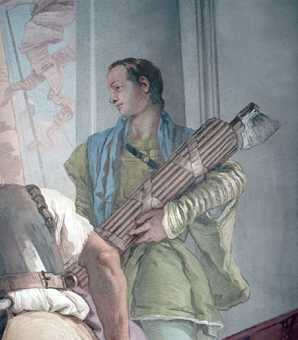

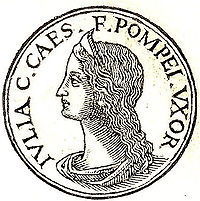



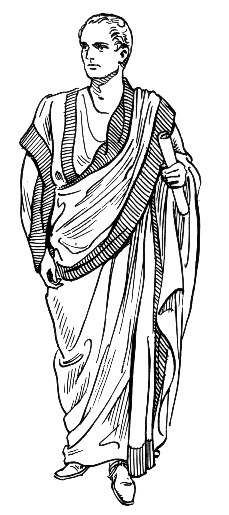



This is the glossary for the books: The October Horse and Caesar and Caesar's Women. This is not a non spoiler thread so any urls and/or expansive discussion can take place here regarding this book. Additionally, this is the spot to add that additional information that may contain spoilers or any helpful urls, links, etc.
This thread is not to be used for self promotion.